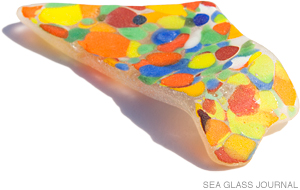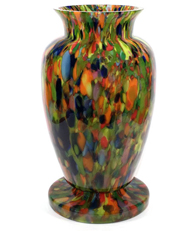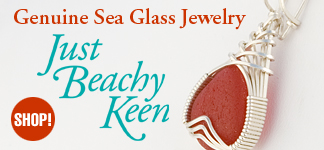The Sea Glass Shard of the Month: July 2015
Spatter Sea Glass

See MORE IMAGES
Sea Glass Specifications:
Color: Multi-Colored
Max Length: 62.5 mm (2.46")
Max Width: 30.2 mm (1.19")
Max Thickness: 7.1 mm (0.28")
Weight: 12.3 grams (0.43 oz)
Estimated Age: 70 to 80 years old
This month we will be looking at an interesting multi-colored sea glass specimen whose origins are possibly from a type of Czech glassware or tableware from the 1930s. This style of glass is referred to as spatter glass which became a popular style of decorative glassware in the late 19th century.
Facts of Interest
Nailsea Crown Glass of Nailsea, England was just one among many glassworks that manufactured this type of glass in the 19th century, and they gave their name to this style.
Spatter glass is hand-blown glass which has been rolled over a hot steel or iron plate to pick up small chips of crushed or powdered colored glass on the outside of the molten glass gather. The glass is then rolled smooth and shaped by blowing, often in a mold, to produce the finished piece. Sometimes a layer of translucent glass is added to coat the outside of the object.
 |
...glass which has been rolled over a hot steel or iron plate to pick up small chips of crushed or powdered colored glass on the outside of the molten glass gather. |
 |
This technique has been used since Roman times with some superb examples of Roman spatter glass vases still in existence. It was also used in the 18th and early 19th centuries as a form of decoration on jugs, vases, decanters and other items made of crude window glass in France, Spain, and England. Several different patents were taken out in the 1880s and 1890s in the USA and in Europe for making various kinds of spatter glass. [1]
Alternative names
There were many different names used for spatter glass in the late 19th century and more recently. Splashed glass, end-of-day glass, mottled overlay glass, spatterglass and others are all generic names which have been applied to the same kind of glass. Note that "end-of-day glass" generally means glass made at the end of the day to use up the glass left in the pots and may not always be an appropriate term for this type of glassware. Although this style of glass decoration was often performed by workers at the end of their shift, so many patents were taken out for this kind of glass that it must be assumed that it was also a normal part of a glassworks' production. [2]
Our conclusion
Spatter glass has been made in Bohemia since the 1880s, and reached a peak of popularity in the 1930s until the war with Germany caused massive disruption to the Czechoslovakian glass industry. Our featured shard has many similarities to the art deco vases produced in Czechoslovakia around this time (see photo) so it is our belief that this sea glass specimen originates from such a glassware product.
REFERENCES:
1. http://www.glassencyclopedia.com
2. Ibid.
Keep up-to-date on all things sea glass... "Like Us" on Facebook... Sea Glass Journal on Facebook







